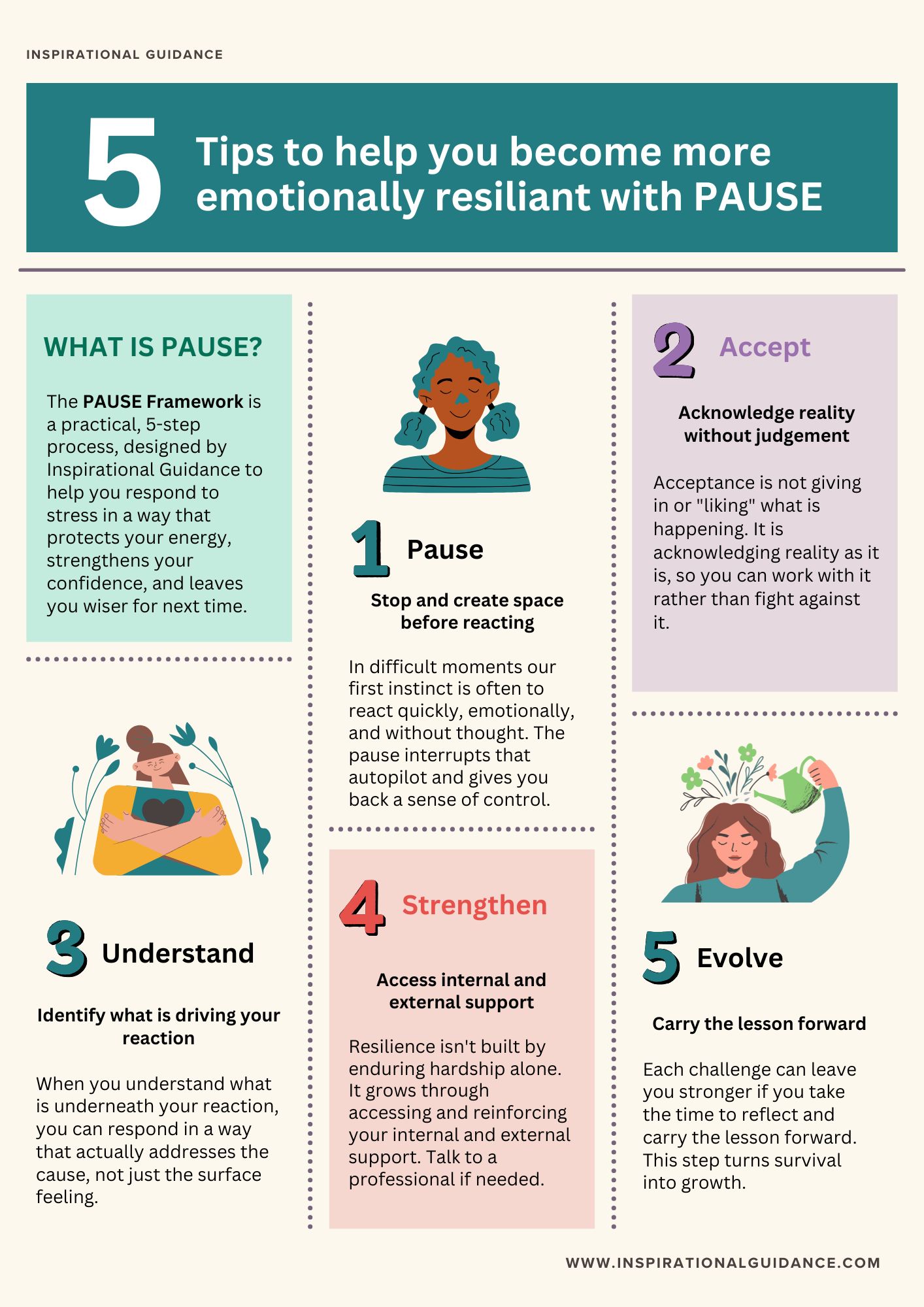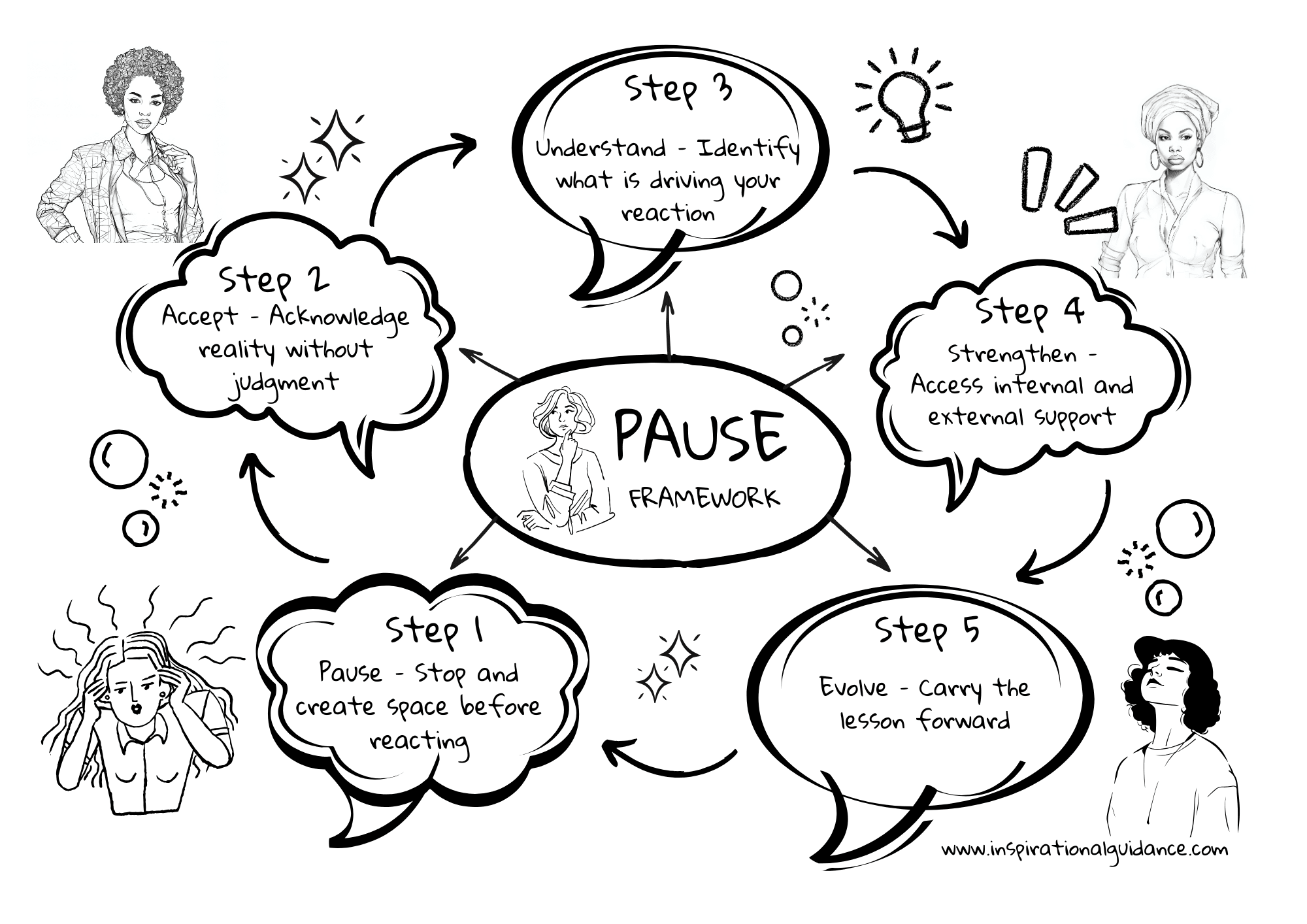The PAUSE Method: A Practical Guide to Emotional Resilience
A simple, repeatable framework to help you meet stressful moments with more calm, clarity, and self‑trust. PAUSE stands for Pause, Accept, Understand, Strengthen, and Evolve.
“Fall seven times, stand up eight.” - Japanese Proverb
What is PAUSE?
The PAUSE Framework is a practical, 5‑step process designed by Inspirational Guidance to help you respond to stress in a way that protects your energy, strengthens your confidence, and leaves you wiser for next time.
- Pause: Stop and create space before reacting.
- Accept: Acknowledge reality without judgment.
- Understand: Identify what’s driving your reaction.
- Strengthen: Access internal and external support.
- Evolve: Carry the lesson forward.

The Five Steps
Pause
Stop and create space before reacting. Breathe. Notice tension. Give yourself permission not to fix everything instantly.
Read moreAccept
Acceptance isn’t agreement; it’s acknowledging what is, so you can work with it rather than fight against it.
Read moreUnderstand
Ask what’s really underneath the reaction. Identify triggers and patterns so you address the cause, not just the symptom.
Read moreStrengthen
Resilience grows by reinforcing inner and outer supports: grounding tools, encouraging self‑talk, and trusted people.
Read moreEvolve
Integrate the lesson and carry it forward. This is how survival becomes growth.
Read more
Pause
In difficult moments our first instinct is often to react quickly, emotionally, and without thought. The pause interrupts that autopilot and gives you back a sense of control. Try a slow breath, drop your shoulders, and notice any urge to rush.
Accept
Acceptance is not giving in or liking what’s happening. It’s acknowledging reality as it is, so you can work with it rather than fight against it. Name the feeling and remind yourself: “This is how it is right now — and I can choose my next step.”
Understand
Ask what’s underneath the reaction: Is this about now, or does it echo something earlier? Identify triggers and patterns so you can address the cause, not just the surface feeling.
Strengthen
Resilience grows through practice and support. Use grounding tools (breath, journaling, a short walk), speak to yourself with encouragement, and lean on trusted people or routines.
Evolve
Each challenge can leave you stronger if you take the time to reflect and carry the lesson forward. Capture one takeaway in your journal or tracker so it becomes part of your toolkit.
Quick Answers to Common Emotional Resilience Questions
What is emotional resilience?
Emotional resilience is the ability to adapt and recover when life doesn’t go as planned. It’s a skill you can strengthen with daily practice. Learn more →
What is the PAUSE method?
The PAUSE method is a simple, five-step framework to help you respond to challenges with clarity instead of reacting on autopilot. Full guide →
How can I pause before reacting?
Take a slow breath, notice your immediate impulse, and give yourself permission to wait before speaking or acting. Step-by-step tips →
What is radical acceptance and how does it build resilience?
Radical acceptance means acknowledging reality as it is, without resistance, so you can work with it rather than against it. Read more →
How does self-awareness boost resilience?
Self-awareness helps you spot emotional triggers, patterns, and strengths, so you can respond instead of react. Find out how →
What micro-habits help build inner strength?
Daily gratitude notes, brief reflection breaks, and practising saying “no” are small habits that add up to greater resilience. See more →
How can I turn setbacks into growth opportunities?
Reframe setbacks as feedback, extract one lesson, and apply it to your next action step. Growth guide →
How can the PAUSE method help me make better decisions?
By creating space between stimulus and response, PAUSE lets you choose actions aligned with your long-term values. Decision-making tips →
How can journaling improve emotional resilience?
Journaling helps you process emotions, track patterns, and build problem-solving skills over time. Journal prompts →
What small steps can I take to start building emotional resilience?
Begin with one small habit, such as a morning breath check-in or ending your day with a “win of the day” note. See examples →
Featured Articles on PAUSE & Resilience
Pause: Why Slowing Down Is the First Step to Handling Any Challenge
Create space before reacting so you can choose your next step with clarity.
Accept: How Radical Acceptance Reduces Stress and Overthinking
Work with reality instead of fighting it — without giving up.
Understand: The Role of Self‑Awareness in Resilience
Spot triggers and patterns so you can respond, not react.
Strengthen: Build Inner Strength Through Micro‑Habits
Small, doable actions that add up to real emotional capacity.
Evolve: Turning Challenges into Growth Opportunities
Integrate the lesson and move forward with more wisdom.
5 Everyday Situations Where PAUSE will help you stay calm and in control
Practical use cases you’ll face this week.
Free Download: The PAUSE Framework For Emotional Resilience
A quick‑start PDF to keep PAUSE at your fingertips. Print it, pin it, or save it to your phone for stressful moments.

FAQ
What’s the quickest way to calm down during a stressful moment?
Use the Pause step: inhale for four, exhale for six, drop your shoulders, and delay responding for 90 seconds. That window is often enough to choose a better next step.
Is PAUSE a mindfulness technique?
PAUSE is mindfulness‑friendly but more action‑oriented. It gives you a simple sequence you can remember under pressure and apply in everyday situations.
How long does it take to build emotional resilience?
Resilience grows through repetition, not perfection. Most people notice a shift within a few weeks of practicing small, daily steps — especially the Strengthen and Evolve stages.
Can I use PAUSE at work or with family?
Yes. It’s designed for real life — difficult meetings, parenting stress, health worries, and relationship tensions. Start with non‑urgent moments to build the habit.

Related Pillars
Build Self‑Confidence
Use resilience to rebuild self‑belief and steady presence.
Self Authorship
If you are not living a self-authored life, then whose life are you living?
Live With Purpose
Use Evolve to realign with your values after setbacks.
Empowered Living
Turn PAUSE into daily habits that empower you.
Journaling
Use journal writing for resilience and confidence. Turn insights into action.
Personal Growth Resources
Free personal development tools to continue your personal growth.
Reflection
This week, give yourself permission to pause before you respond. Note one thing you notice when you slow down.